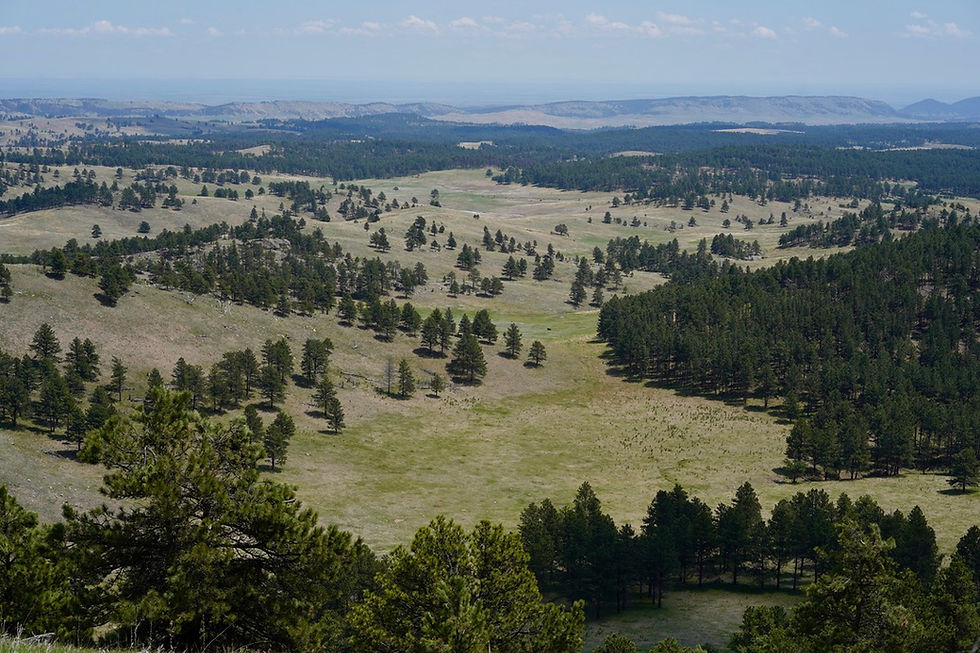Wind Cave National Park: World’s First Cave Park
- Patchwork Eden
- Oct 27, 2019
- 3 min read
Updated: May 16, 2020

Photo by: Jacob Lips
Wind Cave, at 149 miles, is one of the longest caves in the world. Along with the mixed-use prairie above, the park covers 33,847 acres of land, located in Custer County, South Dakota.
There are so many characteristics the Wind Cave is known for, one of which is its beautiful calcite formations. The boxwork formations in the cave represent 95% of all boxwork forms in the world. Wind Cave is also the first cave in the entire world to be declared a national park. Some 650,000 people visited the park in 2018.
History
Native American tribes knew about the cave when they settled in the area, centuries before the arrival of the Europeans. But the first documentation about the cave came in 1881 when brothers Tom and Jesse Bingham found the “hole in the ground.” In 1889, the South Dakota Mining Company tried to find valuable minerals in the cave but failed. So it was developed for tourism.
On Jan. 9. 1903, the Wind Cave National Park was formally established.
Exploring Wind Cave

Photo by: Jacob Lips
There is a whole different but wonderful world inside the cave. The Wind Cave’s natural formations known as speleothems, provide an exciting sight for visitors. These formations are formed when water from above seeps through the limestone and becomes acidic, because of its interaction with carbon dioxide. As the water makes its way through the cave, it dissolves some of the limestone. When it reaches the cave, the air inside the cave dissolves the carbon dioxide in the water. As a result, the water will not be able to hold off all the dissolved calcium with it. The excess calcium is then precipitated in the cave—that is what experts call calcite.
There are various kinds of speleothems in Wind Cave. Visitors should take note of how many types of formations they have identified in the cave. There are at least eight of them in Wind Cave:
Boxwork
This is the most abundant cave formation in Wind Cave, albeit, formed in small amounts. Nowhere else in the world is boxwork this abundant. It almost looks like a honeycomb with its thin blades of calcite protruding from cave walls.
Frostwork
This is just beautiful, like a bunch of snowflakes frozen in time. The frostwork is made of aragonite growing out of the cave’s walls. It usually grows above other formations like boxwork and cave popcorn.
Cave popcorn
This is easily the most identifiable of all speleothems. They are small round objects that sprout through the cave walls.
Dogtooth spar
Small pockets in the cave usually have spear-shaped crystals of calcite along its outline. This is called the dogtooth spar. It is called as such because the crystals look like canine teeth.
Helictite bushes
The formation looks like bushes that grow on the floor of the caves. Some are even as big as trees, with the biggest one inside Wind Cave measuring about six feet. There are different theories regarding helictite bushes, one of which is that they were formed underwater: water rising from below mixed with the cave’s water.
Flowstone / Dripstone
Stalactites and stalagmites, the most common speleothems, are dripstones. This type of cave formation, though, is rare in Wind Cave, which is a surprise among geologists.
Calcite rafts
In the deepest part of the cave is Calcite Lake. Floating through the lake are thin sheets of calcite known as the calcite rafts.
Gypsum
This type of formation is found on the floor of the cave. It is a combination of calcium and sulfur. Sometimes it looks like thin needles of crystals, and other times, it resembles cotton puffs.
Things to do
Aside from exploring the cave and identifying calcite formations, here are some of the activities visitors can enjoy at the park:
Hiking
There are at least 30 miles of hiking trails in the park, which is identified as a mixed-grass prairie. Among the mammals, hikers might spot bison, elk and mountain lions.
Camping
The Elk Mountain Campground has over 60 campsites available on a first-come, first-served basis.
Animal watching
The Wind Cave National Park may be small compared to the other national parks in the U.S. but it is still home to a wide variety of wildlife. A lot of the visitors may be able to spot bison eating grass, which is abundant in a prairie. The park also has prairie dog towns, which are frequented by prairie dogs. The pronghorn antelope prefer the open-space prairie, where they know predators can’t hide. There are hundreds of elk in the park but they are not easy to spot.
As for birds, common in the park are the black-backed woodpecker, Townsend’s solitaire, western meadowlark, and western tanager.

Photo by: Jacob Lips




Comments